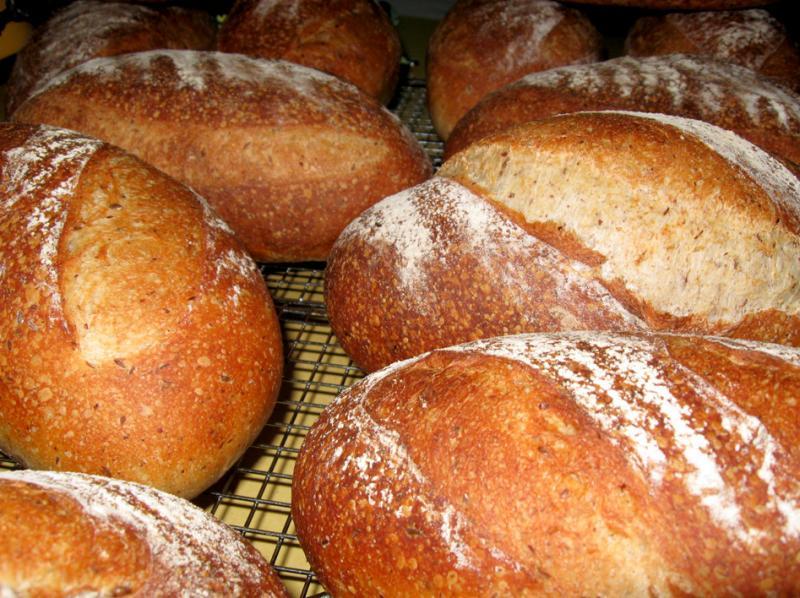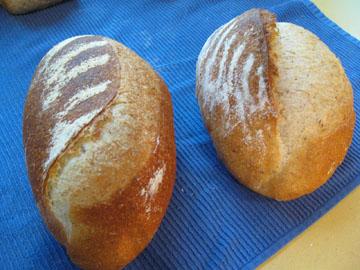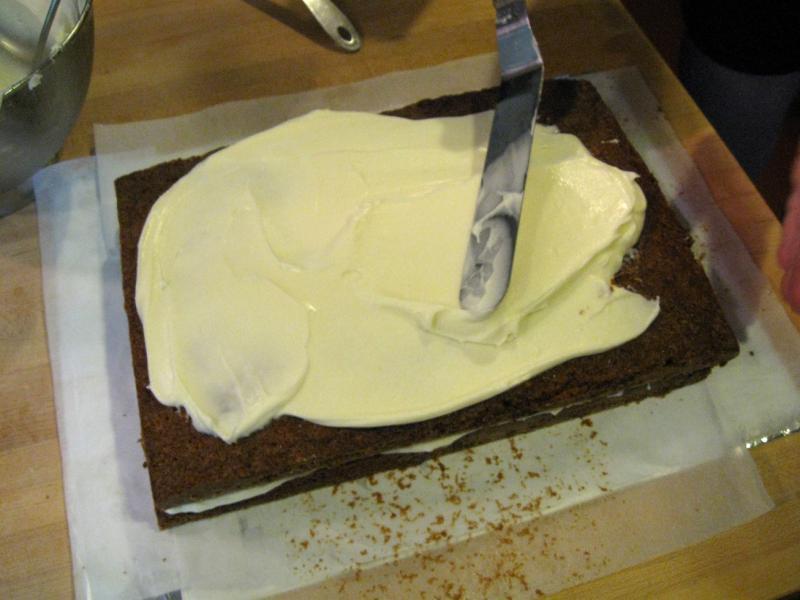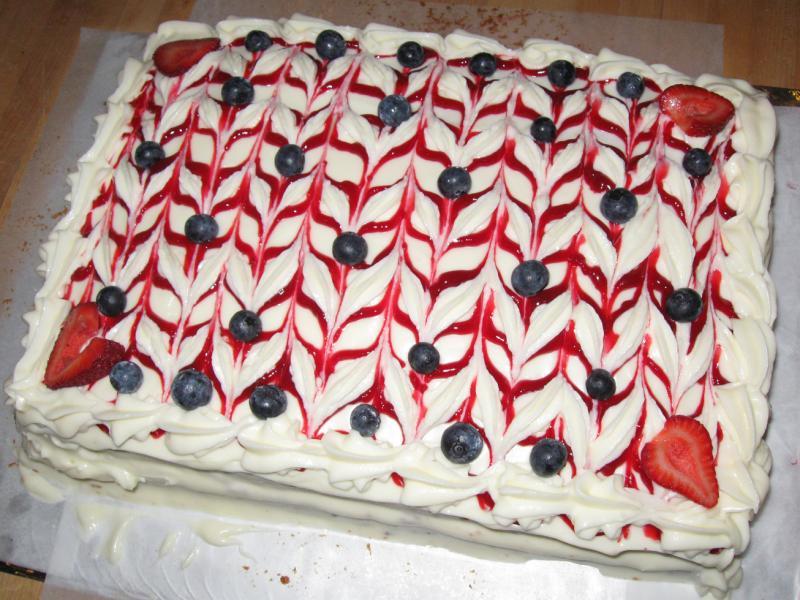-
Posts
89 -
Joined
-
Last visited
Content Type
Profiles
Forums
Store
Help Articles
Posts posted by lizztwozee
-
-
Greetings, bread experts! I've been baking in a commercial gas convection oven for loaves sold at a Farmer's Market, and struggling to get the same spectacular rise I used to, out of my electric oven. I've learned a few things: proofing for longer in the pans makes breads rise higher in the oven; just a little overproofed results in a higher rise in the oven, for some reason. Also using a stone makes a big dif! Even when strap pans are just placed on the stone, the breads seem to be higher. And using steam, of course. But still not nearly as good as with an electric oven, on a stone, with steam just sprayed.
I'm wondering if my first bulk rise could be cooler, and it would create more energy for the second rise, and final oven burst. Currently, I'm bulk rising in a warming oven at 100 degrees or slightly over, for about 1.5 hours. Maybe a cooler 90 degrees (or lower?), for longer would help?
I'm also wondering if turning off the fan for the first 5 minutes or so would make for a higher initial burst, when steam is applied to the sides with a sprayer (also over the tops of the loaves). I've read that gas won't give the same results as electric, and that turning off the fans results in not much.
I've also been told that using a cover, sprayed on the inside with water, over the loaves works well. I've had limited success as far as getting my loaves to look like their electric counterparts, with this technique. And it's a pain!
What's your experience/recommendation?
-
Interesting that a pan of water in the convection oven doesn't work as well as misting; I always assume the mist will burn off instantaneously. I'll try it! And any tips for rising higher in the convection oven are very welcome, thanks!
-
Great thoughts, everyone, lots to think about. There's a large fan in the very back of the oven that turns on and off when the doors are closed and opened; I'm assuming that's the convection fan the sign refers to. It can be turned off with the switch, also. Don't know if there's another fan to extract fumes, as there's no sound of fans running when the main one is turned off.
I would love to know what bread recipes have in them that makes them work better in convection, and I definitely agree that a variation in heat makes for a much more interesting loaf. As for the lower temperature, I've always understood convection makes for faster baking at a lower temp. I should go back to the steaming, however; maybe some of the steam will be blown onto the breads! Thanks for the replies, all.
-
Greetings, expert bakers! I've been baking for farmer's markets in a commercial kitchen for a few weeks now, and am trying desperately to get a prettier product from the gas convection oven I'm using. It has great capacity, and is calibrated perfectly, but bakes so evenly that my breads have an all-over brown color, even the grigne, which makes them look very dull, in my opinion. I was getting fabulous beautiful loaves (and I think they rose higher, too!) from my Vulcan electric, which has a top control, which I set to "high" when the breads went in, on a stone, at 450°. I was able to use steam, also, since there was no fan.
Now I'm baking on a sheet pan at 400° convection, and not really liking the results. So can I just not use the fan? There's a huge disclaimer right on the front of the oven that states the fan MUST be on when the gas is on, yikes! Don't want to blow up the kitchen, but isn't it OK to bake without the fan in a convection oven, usually? Your valuable input gratefully acknowledged, thanks!
-
Thank you, thank you! Yes, the underproofing theory makes perfect sense. I feel better about life now!
-
Oh, and the oven has a large sign that says something like "fan must be on if gas is on" -- does this mean I must bake with convection? I didn't use it at home, but baked at 450°, rather than 400° with convection.
-
Greetings, bakers. I've recently leased a commercial kitchen space to bake a poolish-starter white/whole wheat flax bread to sell at Farmer's Markets. The oven I'm using is a gas convection, with no provisions for steam or stone baking. Just racks and the fan. At home, I was baking on a stone, with steam provided using an old sheet pan and chunks of marble in the bottom, heated with the preheat, and hot water splashed on, when the loaves went in. Now I load the loaves onto a sheet pan, and shove 'em in at 400°F for about 15-20 mins., depending on the size. I get a nice oven burst, and they look great, but I'm finding more tunnels at the tops, than I did with the home baked loaves.
Here's my recipe:
Poolish: 100% hydration
12 oz. strong flour
12 oz. water
1.5 tsp. instant yeast
ferment for at least 4 hours.
add:
65 oz. water (62% hydration)
90 oz. strong flour
20 oz. whole wheat flour
2 oz. ground flax seed meal
1 oz. whole flax seeds
3 T. salt
1.5 tsp. instant yeast
The first rise is at 100° in a warming oven, the second after shaping is at room temperature, which is about 65 degrees (I work in a meat processing plant), and each takes about 1.5 hrs.
I form the loaves in the standard baguette manner, fold, seal, fold, compress and roll a bit, to make 17 oz. torpedo shaped loaves.
What is your experience with large holes at the tops of breads? Are they formed during shaping (my internet search indicated "poor machining of dough" as a reason -- I have no idea what that means!), or is it because of the baking temperature/time/method? Help! No one will buy my loaves if they're holey! Thanks in advance for your expert advice.
-
Greetings, baking professionals! I'm a hobby baker, who's been invited to demonstrate bread forming and braiding techniques at an outdoor art fair. I'm thinking it would be fun to have people watch my demo, then do their own shaping and forming with their own little piece of dough. Everybody wants to learn how to make bread! But the rub is that the dough can't be consumed, as the health dept. will come down on me like flies on sh*t, if you know waddeye mean. So I'm wondering if there's a recipe out there for dough that might kinda act like bread in terms of moisture and texture, but not rise (I'll be outdoors in June), or even be edible, necessarily. Any thoughts?
-
Greetings, baking experts! Somewhere out there is a recipe for a bright white frosting, wedding-cake style, that spreads and smooths easier than a classic buttercream. I thought I saw one once, and it had (gasp) shortening in it? I need a recipe for success, as I'm attempting my first wedding cake, and a satiny smooth frosting is what I'm hoping for. Any tips?
Lizz
-
Thanks, all for your excellent advice. I'm pretty convinced it's the rise that creates the more forceful oven spring. I mistakenly shaved 1/2 hr. off the rise on the 6 loaves that went in together, and came out with the super-grigne. I love the idea of the hot cloche, jackal -- I have read your posts with fascination. Great idea.
-
Yes, please share! I have a beat-up old cookie sheet that I place in the bottom of the oven, and allow to preheat. When the bread goes in, I pour about .25 cup of boiling water on it, and spill a little on the oven door as I'm closing it. I have a Vulcan electric, that has an opening at the back, so the steam goes right out, but maybe a bit hangs around to fall on top of the loaves. I've also tried spraying the tops of the loaves, but that dissolves the flour veil, so I'm not so keen on it.
-
They both are slashed in a long "smile" with a baker's lame, 45 degree angle, then undermined a bit.
-
Greetings, baking experts! The photo below is taken with two loaves of bread, baked at 450 degrees, at 63% hydration, using bread and AP flour, with a little whole wheat thrown in. The one on the left does not have the spectacular "lip" like the one on the right. Any thoughts as to how to plan for this? A few differences in the process: the "lip" loaves seem to happen in the back of the oven, where it's just a bit hotter, and this one may have been baked just a bit less proofed than the one on the left. I bake on a stone, which takes up almost the entirety of my rack, and with an infinite control (commercial electric oven) set to "high". Any thoughts?
Lizz
-
No, I was thinking of each component of my service as something to go with a dish you'd make, or an easy one-course meal; the bread might be offered as a free gift if you order both items. Personal Chef services traditionally don't offer a whole meal, what they might call a "meal" would be a chicken stew and bread, for instance, but not the whole enchilada, vegetables, etc. so to speak. So my goal is to get people to think of my service as a more affordable portion of a larger, more expensive dinner service, where you'd order 20 or so "meals", for a total of say, $325.00. My abbreviated service could be four casseroles and four soup servings for say, $52.00. It's only a few dollars away per serving from the full service, but you could order a smaller amount.
-
Thanks all, for your input! I've often thought a good gauge of how a personal chef service would work in a certain location is what kinds of stores are in the area; Dollar Stores, or Pottery Barn? In my area, there are more Dollar Stores, unfortunately! But the population is in place that will support my idea, I'm convinced; I just need to find the right vehicle for communication, and get in there. Facebook has been phenomenal so far! And thanks for the bread feedback; I kinda got lucky with this batch, I have to say. Practice makes perfect! --Lizz
-
Greetings, all. I had my own Personal Chef biz in 1999, and was shut down after not being able to find an up-to-date coded kitchen to work out of (I was working out of a rental kitchen that had been licensed at one time, but not recently). I made two-course, fresh meals and ran them around to my customers twice weekly, chiilled. What a dream! I had lots of business, even in the pre-Personal Chef years, when people had no idea what it entailed.
Since I will be put on part-time from my full-time advertising job soon, I want to resurrect this idea, but with a twist. So my question is about pricing. I'll offer bread, soup, and a casserole/quiche/stew kinda thang every week, and deliver it fresh to your home, for as many diners as you wish. Does this sound crazy? I'm guessing I can get $3 for a 1-lb loaf of bread (see pics below, it's my passion!), and $10 per serving for the casserole/quiche/stew idea, but am stumped on the quart or pint of soup pricing. I'd like to be able to offer a set price, to keep things simple, and they should include delivery. I've located a kitchen, which is unused on Mondays, in a downtown coffee shop -- I haven't negotiated a price yet, that's another pricing idea I'd like input on! Any ideas? Your input as professionals gratefully acknoweldged, thanks! --Lizz

-
A very amateur's contribution to this thread follows. Someday I will cough up the $825 necessary to take a cake class at the French Pastry School in Chicago, but before then, here's my paltry, if proud contribution. Sherry Yard's carrot cake, with ground almonds in the batter, and melted butter drizzled into an egg-sugar base, then whipped with the dry ingredients. Carrot and coconut then folded in. I added some molasses for kicks! No air condiditioning in my kitchen, however, so the cream cheese frosting was a challenge to pipe. As you can see, it's ready to slide off any minute. Enjoy, and happy 4th!
-
Yes, exactly! My proportion was almost 1-1 of sesame seeds and garnishes, and yes, it did kinda look like an energy bar.
-
Greetings, all. Today's candy experiment results: candy good, camera bad! How was I to know that spending $20 on Craigslist for a digital camera would yield only a few photos before making true the old adage, "you get what you pay for"? Maybe age and maturity should have done the trick, but in this case, it fell to the ground. Similar the area just under my chin.
OK, enough silliness! The candy was a smashing success! Thanks in most part to my egullet advisors, thanks all. I halved the recipe posted previously, substituted karo syrup for the brown sugar, and stirred in dried fruit and nut bits after the syrup had come off the heat, having reached a temperature of 247F. The syrup was just enough to coat the sesame seeds and almost the same quantity of garnishes (in this case chopped raw cashews, figs and pistachios), then conveniently cooled it down enough to press into a greased pan. The candy could then be turned out of the pan while warm in about 5 minutes, and cut into squares. Lovely, and delicious!! If I only had a picture!
The texture was PERFECT. Soft and chewy, and just lightly sweet. I would either increase the honey proportion, or maybe even add a bit of brown sugar, as I think it is too lightly sweet; maybe the additional sugar could be compensated for by lowering the final temperature of the syrup. I'm psyched to try some other flavorings as well. This recipe, having ginger and cinnamon as the spice, gave the candy a slight aroma, which matched well with the honey, which was just a bit apparent, but if I didn't know it was in the candy, I might not have guessed. They were all nicely invisible flavors, and kept the candy from being too bland. I'd love to try some rosewater, or extracts, during my next foray into the land of Food That is Photographed Properly with a Camera That Wasn't Purchased by a Cheap Person. Thanks, all!
-
Excellent! Good tip about the stickiness of the citron; I've had that happen with candied ginger, too.
-
Great information, all! I'll be using your tips this weekend to experiment. Maybe you'll see some pictures, if I can wangle the darn camera. I'm a cook, not a photographer, that's for sure.
The candy sugar emulsion is not carmelized, as the product is uniformly light colored. Come to think of it, the seeds don't look toasted at all -- they have no brown edges that I can see; they're light colored throughout. The fruit and nuts are scarcely studded in there, so I'm guessing they don't affect the moisture level. I'll try bringing the karo syrup up to 250, and stir in the accoutrements, and see what happens.
Here's a recipe I googled to find "sesame candy". It looks like the honey, brown sugar and spices are just briefly boiled (2 min. according to the rec), but that it yields a stiff product, that needs to be scored while hot, then broken apart, like brittle. Maybe the Karo is less sugary and thus doesn't get so stiff? Here are the proportions:
* 2 cups sesame seeds
* 2 tablespoons black sesame seeds, optional
* 1/2 cup honey
* 1/2 cup brown sugar
* 1/2 teaspoon ground ginger
* 1/2 teaspoon cinnamon
* 1/2 teaspoon table salt
Experimentation to come!
Lizz
-
Greetings, pastry chefs! A middle eastern deli in my town sells a sesame and dried fruit/nut candy that is pure heaven. It's not rock-hard or brittle, like some asian sesame/sugar candies I've had, but chewy at room temperature, and made with what looks like some kind of sugar syrup, tons of sesame seeds, dried fruit and nut bits held in the candy by the sugar "glue", and set in a sheet pan as a mold, then cut into soft sticks. I've peppered the owner with questions, if he's about, and he says he uses Karo syrup (it's very lightly sweet, almost not sweet enough), brought to the boil, simmered, then combined with hot toasted sesame seeds, and dried fruit bits and nuts. So in trying to recreate the recipe, do you think the syrup is brought to a specific temperature, and that the heat from the sesame seeds needs to be accounted for? Since it's a candy product, I'm guessing we have to be kinda accurate, although the owner of the shop seems kinda "loosey goosey"! Maybe he's guarding the secret carefully, I dunno. Any thoughts?
-
So Andiesenji -- I'm getting psyched about honey cookie recipes, but I'm not sure what "citron ground fine" is in the Lebkucken Honey Cookie recipe you posted a link to. Any tips? It calls for a pound. They look just like the cookies I always buy from my favorite import food store, which I always wanted to know how to make. --Lizz
-
-- if there's a fire and they trace it back to anything in the vicinity of your Vulcan, you won't be covered.
Yep, you're right . . . interestingly enough, when I ordered the oven/range from the vendor, the specs indicated there could be "zero inches clearance to combustible materials", even though they did not advocate installing it in the home. So I thought I'd be double safe by enlarging the countertop so it doesn't actually touch the edges of the stove. I think it should be OK! Thanks for the note.







Looking for a Better Bread Rise with Convection
in Pastry & Baking
Posted
Here are a couple of photos that will illustrate the sorry story; note how lovely the multiple breads are with regards to rise and color, in comparison to the flat single loaf! Gaaaaaa. Amazingly, my breads are raved about, and sell out every weekend. I think some of the people are being fooled all of the time!
http://caledonia.patch.com/blog_posts/flax-seed-whole-wheat-bread-by-the-traveling-chef#photo-6696514